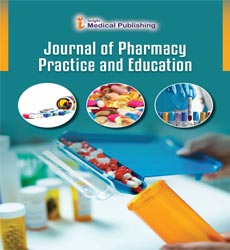Bio-Medical Waste Management
Priya Datta*
Department of Microbiology, Government Medical College Hospital, Chandigarh, India
- *Corresponding Author:
- Priya Datta
Department of Microbiology,
Government Medical College Hospital,
Sector 32, Chandigarh,
India;
Email: drpriyadatta11@hotmail.com
Received Date: July 09, 2021; Accepted Date: July 23, 2021;Published Date: July 30, 2021
Citation: Priya D (2021) Bio-Medical Waste Management. J Pharma Prac Edu Vol.4 No.4:39.
Introduction
Biomedical waste (BMW) is any waste delivered during the finding, therapy, or vaccination of human or creature research exercises relating thereto or in the creation or testing of organic or in wellbeing camps. It follows the support to grave methodology which is portrayal, measurement, isolation, stockpiling, transport, and treatment of BMW. The developing quantum of clinical wastes (otherwise called biomedical wastes or medical services wastes) is presenting huge general wellbeing and ecological difficulties across the world. The circumstance is disturbing in agricultural nations because of inappropriate removal techniques, inadequate actual assets, and absence of examination on clinical waste administration [1]. The significant innovations for clinical waste treatment incorporate steam disinfection, progressed steam sanitization, microwave treatment, dry warmth cleansing, soluble hydrolysis, organic treatment and plasma gasification.
Steam sterilization
Steam disinfection (or autoclaving) is the most widely recognized elective treatment strategy. Steam disinfection is done in shut chambers where both warmth and pressing factor are applied throughout some stretch of time to annihilate all microorganisms that might be available in medical care waste before landfill removal. Among elective frameworks, autoclaving has the least capital expenses and can be utilized to measure up to 90% of clinical waste [2], and are effectively scaled to address the issues of any clinical association.
Advanced autoclaves: Advanced autoclaves or advanced steam treatment innovations join steam treatment with vacuuming, interior blending or discontinuity, inward destroying, drying, and compaction consequently prompting as much as 90% volume decrease. Advanced steam frameworks have higher capital expenses than standard autoclaves of a similar size. Notwithstanding, rigorous waste isolation is important in steam disinfection to prohibit risky materials and synthetic substances from the waste stream.
Microwaves
Microwave treatment is a promising clinical garbage removal innovation in which treatment happens through the presentation of wet warmth and steam produced by microwave energy. A common microwave treatment framework comprises of a treatment chamber into which microwave energy is coordinated from a microwave generator. Microwave units by and large have higher capital expenses than autoclaves, and can be bunch or semi-constant.
Chemical processes
Chemical processes use sanitizers, like lime or peracetic corrosive, to treat squander. Soluble absorption is a one of a kind sort of chemical interaction [3] that utilizations warmed antacid to process tissues, obsessive waste, physical parts, or creature corpses in warmed hardened steel tanks. Natural processes, such as treating the soil and vermicomposting, can likewise be utilized to corrupt natural matter in medical services waste like kitchen/food waste and placenta.
Plasma gasification
Plasma gasification [4] is an arising and promising choices for clinical garbage removal. A plasma gasifier is an oxygen-starved reactor that is worked at the extremely high temperatures which brings about the breakdown of squanders into hydrogen, carbon monoxide, water and so forth. The principle result of a plasma gasification plant is energy-rich syngas which can be changed over into warmth, power and fluids powers. Inorganic parts in clinical squanders, similar to metals and glass, get changed over into a lustrous total.
Managing waste
Probably the greatest test the public authority emergency clinics and little HCFs will confront, during the execution of BMW 2016 guidelines will be because of the absence of assets. To eliminate chlorinated plastic packs, gloves, blood sacks and to build up a scanner tag framework for sacks/holders the expense will be high and period of time for doing this for example two years is excessively short. Presently, in India, there are 198 CBMWTF in activity and 28 are under construction. There is an extraordinary requirement for fast improvement of a lot more CBMWTF to satisfy the need of treatment and removal of all BMW produced in India. Incinerator radiates poisonous air contaminations, and incinerator debris is possibly unsafe.
Conclusion
Bio-medical waste management(BMWM) ought to be a common cooperation with submitted government backing, great BMW rehearses followed by both medical care labourers and HCFs, constant checking of BMW rehearses, and solid lawmaking body. It is our key right to live in perfect and safe climate. The mainstay of BMWM is isolation of waste at source and WR. The current BMWM 2016 standards are an improvement over prior rules as far as further developed isolation, transportation, and removal strategies, to diminish natural contamination and guarantee the wellbeing of the staff, patients, and public. In addition, more utilization of non-PVC medical gadgets and advancement of fresher novel, ecoaccommodating frameworks for removal of BMW ought to be supported. All members in BMWM should vow to ensure a cleaner and greener climate.
References
- David L, Richard G (2014) In: Minamata Convention on Mercury, Ratification and Implementation Manual. 25:5.
- Li CS, Jenq FT (1993) Physical and chemical composition of hospital waste. J Infect Control Hosp Epidemiol 14:145–150.
- Mattiello A, Chiodini P, Bianco E, Forgione N, Flammia I, et al. (2013) Health effects associated with the disposal of solid waste in landfills and incinerators in populations living in surrounding areas: A systematic review. J Int Public Health 58:725-735.
- Nema SK, Ganeshprasad KS (2002) Plasma pyrolysis for medical waste. J Curr Sci 83(3):271-278.
Open Access Journals
- Aquaculture & Veterinary Science
- Chemistry & Chemical Sciences
- Clinical Sciences
- Engineering
- General Science
- Genetics & Molecular Biology
- Health Care & Nursing
- Immunology & Microbiology
- Materials Science
- Mathematics & Physics
- Medical Sciences
- Neurology & Psychiatry
- Oncology & Cancer Science
- Pharmaceutical Sciences
